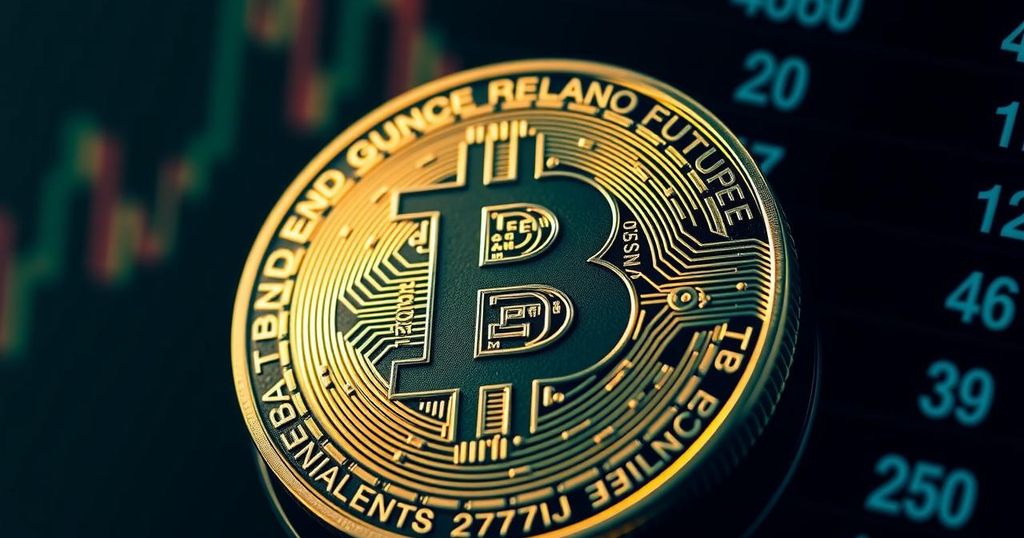Bitcoin Price Holds Steady at $62K Amid Federal Reserve Scrutiny and Inflation Data
Bitcoin’s price held steady at about $62,466.2 as traders awaited insights on U.S. interest rates from the Federal Reserve alongside inflation data. The recent volatility in crypto markets reflects mounting caution among investors due to slow interest rate cuts and external geopolitical factors. Meanwhile, altcoins exhibited slight increases, maintaining a largely rangebound status. Traders are closely monitoring upcoming economic indicators that could influence future price movements.
On Wednesday, Bitcoin’s price stabilized at approximately $62,466.2 following recent declines, as traders awaited further insights regarding U.S. interest rates from the Federal Reserve and upcoming inflation data. The world’s largest cryptocurrency has seen its recovery stalled, influenced by traders integrating a slower trajectory of interest rate reductions by the Fed into their strategies. A stronger dollar has also contributed to downward pressure on the broader cryptocurrency market, reflecting a decrease in risk appetite among investors. In the early hours, Bitcoin experienced a marginal decrease of 0.1%. The market’s attention is significantly directed towards the forthcoming release of the minutes from the Federal Reserve’s September meeting, which are anticipated later today. During that meeting, the Fed implemented a 50 basis point rate cut and initiated an easing cycle, indicating a shift in monetary policy. Recent robust payroll statistics have instigated debates regarding the Fed’s necessity to sustain aggressive rate cuts. Current market indicators suggest an 84.1% probability that the Fed will enact a 25 basis point cut in November, with a 15.9% probability that the rates will remain unchanged, as reported by CME Fedwatch. Attention is also on the consumer price index inflation data scheduled for Thursday, given that the Fed has indicated that its future rate reductions will be closely tied to inflation and labor market conditions. Lower interest rates typically favor speculative investments, including cryptocurrencies. However, the anticipated gradual rate cuts might lead to heightened caution among traders within the cryptocurrency market in the short term, particularly if the U.S. terminal interest rate remains high, which would negatively impact the sector. Despite fluctuations in the market, Bitcoin has remained within a trading range between $50,000 and $65,000 since June, showing little inclination for a breakout. Traders are on the lookout for definitive catalysts to drive crypto prices upward, which may include upcoming options offerings linked to BlackRock’s spot Bitcoin ETF. Furthermore, Bitcoin has not mirrored the recent rally seen in U.S. stock markets after the Fed’s prior rate cut and has faced considerable challenges due to rising risk aversion stemming from geopolitical tensions, particularly the Israel-Hamas conflict. Nonetheless, a potential political development has emerged as a supportive factor for cryptocurrencies. According to data from the crypto betting platform Polymarket, former President Donald Trump appears to be leading Vice President Kamala Harris in the projected outcome of the 2024 presidential elections, which is perceived positively by crypto enthusiasts due to Trump’s favorable stance towards cryptocurrencies. In the broader cryptocurrency space, altcoins showed minor increases but remained largely stagnant. For instance, Ether, the second-largest cryptocurrency, saw a rise of 0.9%, priced at $2,450.46. Other cryptocurrencies, such as SOL, XRP, ADA, and MATIC, experienced slight upticks, while meme coins like DOGE registered a gain of 1.2%.
The cryptocurrency market is influenced heavily by global financial conditions and monetary policy decisions made by central banks such as the U.S. Federal Reserve. As traders anticipate economic adjustments, including interest rate changes and inflation measurements, their trading behavior often reflects these influences. Bitcoin, as the most prominent cryptocurrency, is particularly sensitive to shifts in investor sentiment driven by these macroeconomic factors. As interest rates shift, they can affect the attractiveness of riskier assets, such as cryptocurrencies, impacting their price movements. The current context reflects a pivotal moment where traders are carefully weighing the implications of the Fed’s decisions alongside evolving economic indicators.
In summary, Bitcoin’s price remained steady at approximately $62,466.2 as the market awaits critical insights from the Federal Reserve regarding monetary policy and inflation data. The cryptocurrency continues to navigate a constrained trading range amid macroeconomic pressures and evolving investor sentiment. Upcoming economic indicators and potential geopolitical developments will play crucial roles in shaping Bitcoin’s price trajectory and the broader cryptocurrency market in the near future.
Original Source: in.investing.com








Post Comment